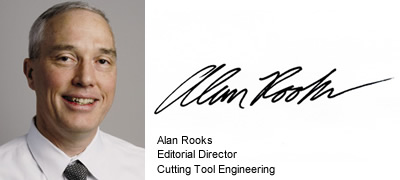Metalworking barometer headed up?
Metalworking barometer headed up?
IMTS serves as a convenient benchmark for the health of the U.S. metalworking industry, allowing comparisons with the last go-round, and the ones before that.
The International Manufacturing Technology Show, better known as IMTS, is nearly here again. Because it rolls around every 2 years in mid-September, IMTS is a convenient benchmark for the health of the U.S. metalworking industry, allowing comparisons with the last go-round, and the ones before that.
The 2014 edition will be my fifth IMTS, a small number compared to many industry veterans, but enough to gauge the general arc of the industry. At IMTS 2006, metalworking was in the midst of strong growth, and spirits were high. In 2008, things appeared to be going swimmingly, despite rumblings in the real estate market. Then, on Sept. 15, 2 days after IMTS 2008 ended, Lehman Brothers filed for bankruptcy, and, well, you know the rest.
Metalworking seemed to stop on a dime during the Great Recession. Yes, parts were made, but it seemed that almost no one was investing in machine tools, cutting tools or other equipment. Then, as the auto industry came back to life in 2009, metalworking began to recover as well. By IMTS 2010, U.S. manufacturing was growing strongly, though the recovery in the general economy was decidedly more tepid, and in 2012 the story was nearly the same. Today, the growth in manufacturing and metalworking has slowed somewhat, but the expansion continues.
Can it continue further? Will IMTS 2016 see us smiling or frowning? It appears that the manufacturing comeback still has legs—maybe more than any of us could have imagined in the dark days of 2008-09.
"For the last 3 years, manufacturing activity has been growing more rapidly than the overall U.S. economic GDP," wrote Bill Greiner, chief investment officer of Mariner Wealth Advisors, Leawood, Kan., in a July 9 blog on the Forbes magazine Web site. "This is the first time this has happened in more than 50 years. I believe the factors that have led to this oddity are sustainable and that manufacturing and overall industrial growth will probably continue to outpace overall GDP growth rates in the United States for some time."
Why is this the case? Greiner noted that many global manufacturing costs are becoming more level, which benefits the U.S. For example:
Greiner's analysis is in line with many other commentaries on the manufacturing recovery. In short, U.S. manufacturing is growing, but jobs—not so much. According to the Bureau of Labor Statistics, manufacturing employment in the U.S. fell by 15 percent from 2002 through 2012, despite the economic recovery. A key reason is that real manufacturing output per U.S. worker is up sharply. It tripled, in 2005 dollars, from 1970 to 2009, from just under $60,000 to $180,000, which means you would've needed one worker in 2009 to produce the output of three in 1970.
That trend continues. For example, in July, Boeing announced that a new automation process was in the final phase of testing. In a building under construction in Everett, Wash., Boeing will use automated, guided robots to fasten the panels of 777 fuselages together, drilling holes and filling them with more than 60,000 fasteners currently installed by hand for each plane. I'm not sure exactly what that means, but it sounds ominous for some of Boeing's workers.
So, with IMTS 2014 arriving in September, things are looking positive for manufacturing—provided you are in management or are one of the increasingly elite group of workers who have the skills still needed to run a manufacturing operation. CTE


